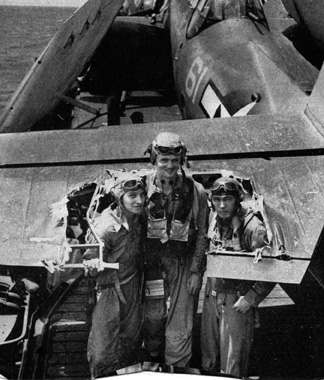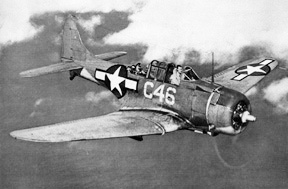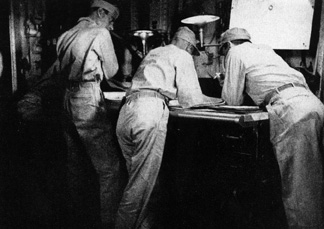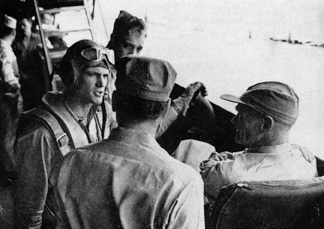|
U.S. Naval Aviation In the South Pacific during WW II Featuring the Lexington Aircraft Carrier The Battle of the Marianas — June 1944 Chapter 1 Page 3 of 7 Pages |
||||||||||||
| Last night it looked as though Plan Johnny had been a flop. Today it proves to have been spectacularly successful. This was due to an oddity apparently typical of carrier warfare. Last night pilots from this ship found few planes on the airfields which were their targets and no fighter opposition in the air. Since the fighter pilots wanted to boost their own and their squadron’s score, they came back sore and disappointed. Through the evening, however, reports from other carriers indicated that this paucity of prey was a pure mischance. At other airfields, grounded planes were plentiful; a squadron from another carrier surprised a covey of planes in the air and destroyed them all. The total score now seems to be 124 Japanese planes destroyed, against a total loss for us of 11.
Today, however, there is also a new and even more sensational subject for “scuttlebutt” than our own battle; this is that the Japanese fleet is on the move. As yet no one is sure whether it is headed for us or for General MacArthur’s newest landing at Biak. However, the former looks like the best bet. |
||||||||||||
 |
||||||||||||
|
Ctsy: Life Mag., dated 6/17/44 |
||||||||||||
| June 13: Strikes at Saipan continued all day; we lost three pilots to antiaircraft fire. Mitscher said today of Saipan, “The Japs don’t know it, but we’re going to stay here a long time. Yes, this place will look like home to us before we’re ready to get out.” |
||||||||||||
| June 14: ----- Our casualties have been remarkably light so far, but today we had one especially grave one: the skipper of Torpedo Squadron 16, Commander Robert H. Isely. This squadron, like our dive-bomber squadron led by Lieut. Commander Ralph Weymouth, and fighter squadron, headed by Commander Paul Buie, is, on its statistical record, one of the three or four best in the Navy. -----
June 15: (D-day). The landing went off in good order against strong shore resistance. Toward the middle of the morning I took my courage in both hands — by no means difficult, since two fingers would suffice — and got permission to accompany a dive-bomber strike against gun positions in support of the Marine landings. The lieutenant who piloted the plane treated me with deeply courteous consideration as though Saipan’s neat brown fields, green slopes and empty coral roadways had been perhaps sights of his home town and he had no other concern on his mind than to point them out to me. When a close burst of antiaircraft fire beneath us caused the plane to buck, he hurried to ask whether I was okay and, when I said I was, explained that he planned to make his dive in a moment. The sensation of diving was, I found, much like that of a roller-coaster, only moreso. When we leveled out, the plane began bucking ominously again. The pilot called to say somewhat apologetically that he didn’t know why the Japanese antiaircraft gunner seemed to be picking especially on us and that he thought he had better climb into a cloud and put a stop to it. I offered no objections. For a person with a limited appetite for excitement and one who hates roller-coasters, this would have been ample diversion for one day, but it turned out to be only the hors-d’oeuvres. Before supper was over this evening, several “bogeys” — as unidentified planes are called under such circumstances — were seen approaching from different directions, low on the water. I barely had time to step out on the starboard or outboard side of the bridge before several ships on our starboard quarter opened fire. |
||||||||||||
 |
||||||||||||
|
Ctsy: Life Mag., dated 6/17/44 |
||||||||||||
 |
||||||||||||
|
Photo Ctsy. Life Inc. |
||||||||||||
 |
||||||||||||
|
Below: Bomber squadron commander visits Mitscher’s bridge to report on Saipan air operations. |
||||||||||||
 |
||||||||||||
| Pointed out by the long red lines of tracer bullets in the dusk, a Japanese plane became apparent an instant later, about a thousand yards astern of us. For a space of perhaps two long seconds the outline of the plane grew larger as it came in directly toward us. Then there was a flash of fire, followed by a spout of water as it hit the sea.
A moment later there was a deafening roar which came apparently from a spot about two inches from my left ear. Now, from a reclining position on the narrow deck, I looked up just in time to see a twin-engined plane flash past overhead at a distance of perhaps 20 yards, followed by a streak of red fire from our own batteries. This Japanese plane, which had come in off our port bow while we looked the other way, banked and dipped as it skimmed over the water away from us. Getting back on our feet we saw it explode into a second lively bonfire on the smooth dark sea. All of us, looking down over the rail at this point, observed a particular ripple in the water a few feet off the beam. What this ripple was I had no idea until it had passed, parallel to the ship, out of my sight, hidden by a projecting gun gallery. An intelligence officer standing at my right then said to me quietly, “Did you see that torpedo wake?” I answered that I had. Then I discovered that, in fact I had missed the show entirely. On our side of the bridge the most disturbing objects had been a Japanese torpedo bomber at 20 yards and a torpedo at 20 feet. On the port side, on the other hand, another Japanese torpedo plane had come in directly at the ship from almost dead ahead. Our own guns or those of another ship had hit this plane before it reached us. It had burst into flame just ahead of our bow and then flown down the entire length of our flight deck, about 30 feet above it, burning so furiously that the heat of the flames made a hot wind in the faces of onlookers who had had no time to duck as it passed the bridge. The Japanese pilot, who was probably dead by the time the plane passed over our flight deck, had obviously tried to make a suicide dive in his last conscious instant. The plane had begun to tip its right wing as it passed the bridge but, in crashing, it missed the deck by 20 feet or so and hit the water a few yards off our stern. Chapter 1— End of Page 3 of 7 Pages — Go to Page 4 Page —1 — 2 — 3 — 4 — 5 — 6 — 7 Or This Story’s Cover Page — Editor’s Introduction — Table of Contents Fred Gwynn’s “Torpedo 16” — Chapter — 1 — 2 — 3 — 4 Or Home - Contact Us - Cold War Hist. - 91st SRS Hist. - Stardust 40 Mission Story |
||||||||||||